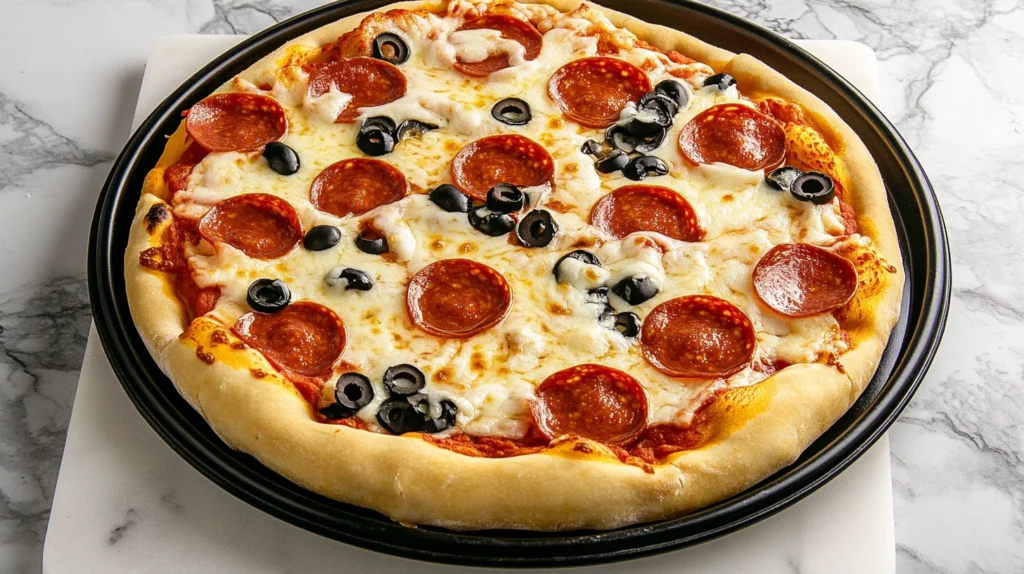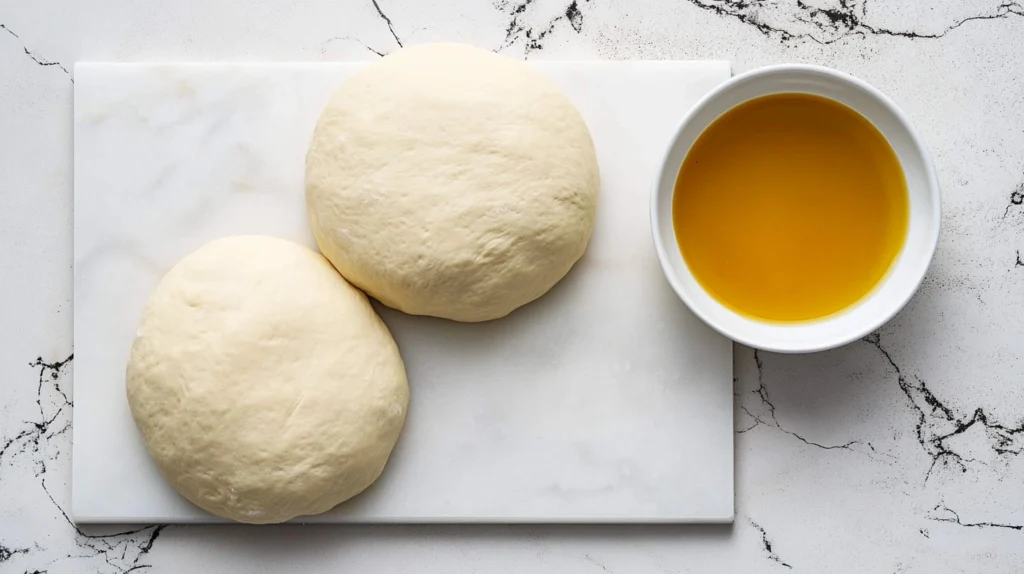Have you ever found yourself asking, “How much dough for a 14-inch pizza?” It’s a common question for anyone eager to make pizza from scratch, but don’t worry, we’ve got you covered! First, making your own pizza dough is easier than you might think. It’s not only a fun cooking challenge but also a healthier option. Imagine biting into a fresh, homemade pizza with the perfect dough—crispy on the outside and soft on the inside. Then, you can get creative by customizing the toppings however you like. The best part? It’s super versatile and delicious! Whether you’re hosting a pizza night or just treating yourself, this dough recipe will never disappoint. In addition, it’s simple enough for anyone, even beginners, to master. Ready to make the perfect 14-inch pizza? Keep reading to discover how much dough you’ll need and how to make it just right!
Determining the Right Dough Amount
Factors Affecting Dough Quantity
When you’re asking, “How much dough for a 14-inch pizza,” it’s important to think about the factors that affect the amount you’ll need. The dough’s thickness, the type of crust you want, and how thin or thick you prefer your pizza all play a role. Typically, you’ll need about 1 to 1.5 pounds of dough for a 14-inch pizza. If you like a thicker crust, you may need a bit more, while a thinner crust will require less. It’s all about balancing your preferences with the dough’s ability to rise and hold toppings without getting too thin. So, next time you’re preparing, keep these factors in mind to get the perfect amount of dough for your pizza!
| Factor | Influence on Dough Quantity |
| Dough Thickness | Thicker crust requires more dough (up to 1.5 pounds) |
| Type of Crust | Stuffed crust needs more dough (1.5 to 2 pounds) |
| Pizza Size | A 14-inch pizza typically needs 1 to 1.5 pounds of dough |
| Personal Preference (Thin or Thick Crust) | Thicker crust = more dough, thinner crust = less dough |
Ideal Dough Weight for 14-Inch Pizza
When making a 14-inch pizza, the ideal dough weight is around 1 to 1.5 pounds. This amount of dough ensures you have enough to cover the pizza pan with the right amount of thickness, whether you prefer a slightly thicker or thinner crust. If you’re aiming for a perfectly balanced pizza, this weight will give you the flexibility to stretch it out just right, without feeling too thin or too thick. Keep in mind that dough can rise, so it’s always a good idea to work with a little extra dough just in case. The key is finding that perfect weight to match your taste.
Preparing the Dough
Mixing Techniques for Consistent Dough
The key to getting the right dough for your 14-inch pizza starts with the mixing process. First, combine your flour, water, yeast, salt, and sugar. Then, mix them until you get a smooth, sticky consistency. Be sure not to over-mix, as this could lead to a tough dough. You’ll want a soft, slightly elastic dough that can be stretched without tearing. The dough consistency matters because it will influence the final pizza texture. To get it just right, let it rest before using. This resting period helps develop the gluten, making it easier to work with.
| Ingredient | Amount | Purpose |
| Flour | 2-3 cups | Main ingredient for dough base |
| Water | 1 to 1.25 cups | Activates yeast, hydrates flour |
| Yeast | 1 teaspoon | Helps dough rise |
| Salt | 1 teaspoon | Adds flavor and strengthens dough |
| Sugar | 1 teaspoon | Fuels yeast, enhances taste |
Kneading Tips for Optimal Texture
Kneading your dough is just as important as mixing it! Once you’ve combined your ingredients, knead the dough on a floured surface for about 8-10 minutes. This process helps activate the gluten, which gives your dough its chewy, elastic texture. If you notice the dough is sticking to your hands, dust it lightly with flour, but avoid using too much. The goal is to get a dough that’s smooth, elastic, and soft. After kneading, let the dough rest so it can rise properly, which will give your pizza that perfect texture when baked.
Adjusting Dough for Different Crusts
Thin Crust vs. Thick Crust Adjustments
When deciding how much dough for a 14-inch pizza, consider the type of crust you want. If you’re after a thin crust, use around 1 pound of dough. For a thicker, more substantial crust, you’ll need up to 1.5 pounds. Thin crusts bake faster and are more crisp, while thicker crusts offer a soft, airy texture inside with a slightly chewy bite. You can adjust the dough by simply rolling it thinner for a crispier outcome or leaving it thicker for a hearty base. These simple adjustments ensure that your pizza turns out just the way you like it!
| Crust Type | Dough Weight | Resulting Texture |
| Thin Crust | 1 pound | Crisp, quick bake, lighter texture |
| Thick Crust | 1.5 pounds | Soft, airy inside, chewy bite |
| Adjusting Thickness | Varies by preference | Thinner = Crispier, Thicker = Heartier |
Handling Dough for Stuffed Crusts
If you’re thinking about a stuffed crust for your 14-inch pizza, you’ll need a bit more dough. Typically, a stuffed crust requires at least 1.5 to 2 pounds of dough to ensure it holds the cheese and toppings inside. To prepare, roll out your dough just as you would for a traditional pizza, but leave extra dough around the edges. Fold the edges over and seal the cheese inside, creating a crust that’s both crispy and filled with flavor. Stuffed crusts are a fun twist on the classic pizza, and the extra dough ensures a satisfying, cheesy bite with each slice.
Storing and Proofing Pizza Dough
Best Practices for Dough Storage
If you have leftover dough after preparing your 14-inch pizza, it’s important to store it properly to keep it fresh. To store dough, wrap it tightly in plastic wrap or place it in an airtight container. Afterward, keep it in the refrigerator for up to 3 days. The cold environment slows down the fermentation process, which helps the dough maintain its flavor and texture. When you’re ready to use it again, simply take it out of the fridge and let it come to room temperature before stretching it out. This method ensures your dough stays fresh and ready for your next pizza creation.
Proofing Methods for Better Rise
Proofing dough is a crucial step in getting a light and airy pizza crust. After mixing your dough, place it in a lightly oiled bowl and cover it with a damp towel. Let it sit in a warm place for at least 1 hour, or until it doubles in size. Proofing gives the yeast time to work, creating air pockets that make your dough rise. If you’re short on time, you can speed up the proofing process by placing the dough in a warm oven or using the refrigerator for an overnight rise. Either way, proofing helps the dough develop a flavorful, soft texture that’s perfect for pizza.
Now that you’ve got the perfect dough, it’s time to bring your pizza dreams to life—let’s dive into making a classic Neapolitan-style pizza that’s sure to impress!
Ingredients For Dough For 14 Inch Pizza

First, let’s gather the ingredients you’ll need for the perfect dough to make a 14-inch pizza!
Flour – This is the base of your dough and provides the structure. You can use all-purpose flour, but bread flour will give it a little extra chewiness, which is always a win!
Water – Water hydrates the flour, activating the yeast and allowing the dough to rise. It’s like the secret agent that makes everything come together!
Yeast – Yeast is the magic ingredient that helps the dough rise, giving your pizza that fluffy, airy texture. Without it, your dough would be as flat as a pancake!
Salt – A pinch of salt is not just for taste but also strengthens the dough, helping the yeast do its thing. It keeps everything balanced.
Olive Oil – This adds a bit of richness and flavor to your dough. Plus, it helps the dough stretch better and gives your crust a golden finish.
Step-by-Step Pizza Dough Instructions

Now that you have your ingredients, let’s make this dough! It’s easier than you might think. Just follow these steps, and you’ll be enjoying pizza in no time!
Step Action 1 – Start by combining your flour, yeast, and salt in a large bowl. Mix them together so they’re all evenly distributed. This ensures the yeast works its magic evenly.
Step Action 2 – Gradually add the water to the dry ingredients. Stir it all together until it starts forming a dough. Don’t be afraid if it’s a little sticky—this just means it’s on track!
Step Action 3 – Once the dough starts to come together, turn it out onto a floured surface and knead it. You’ll want to knead for about 8-10 minutes until the dough is smooth and elastic. This is important for giving the dough its perfect texture.
Step Action 4 – Place the dough in a lightly oiled bowl, cover it with a damp towel, and let it rise for about 1-2 hours. It should double in size! This is the fun part when the dough gets all puffy and airy.
Step Action 5 – After your dough has risen, punch it down gently and divide it into portions if needed. You’re now ready to roll it out into your perfect 14-inch pizza base!
Serving

Once your pizza dough is ready, it’s time to serve! Here’s how you can enjoy your freshly made 14-inch pizza dough.
This recipe serves 1-2 people.
Serve it hot – Stretch and top the dough with your favorite pizza sauce, cheese, and toppings. Then, bake it at 475°F for around 10-12 minutes for a crispy, golden crust!
Optional garnishes or pairings – Pair your pizza with a side salad or a cold drink for a well-rounded meal. Want to mix it up? Try adding a drizzle of olive oil or a sprinkle of fresh basil right after baking.
For a fun twist, try experimenting with different types of flour for a unique flavor and texture!
Tips and Hacks: Dough For 14 Inch Pizza
Here are a few tips to help you take your pizza dough game to the next level:
Tip 1 – Add a teaspoon of honey to the water to help activate the yeast faster and give your dough a slight sweetness.
Tip 2 – If you prefer a crunchier crust, use a pizza stone to bake your pizza. Preheat it in the oven before placing the dough on it!
Tip 3 – You can easily double or triple this recipe for a pizza party! Just make sure to adjust the baking time for the larger pizzas.
Tip 4 – Store any leftover dough in an airtight container and refrigerate it for up to 3 days. It’s even better the next day after a slow rise in the fridge!
Nutrition Facts
Serving size: 1/2 pizza
Calories: 230
Fat: 7g
Carbs: 30g
Protein: 5g
Sodium: 300mg
Fiber: 2g
Please note: These values are estimates based on ingredient brands, portion sizes, or preparation methods.
Prep Time to make Pizza Dough
Prep time: 10 minutes
Cook time: 12 minutes
Total time: 1 hour 30 minutes (including rise time)
Please note: The prep time may vary depending on your kitchen tools and the temperature in your home.
FAQs
Adjusting Pizza Dough for Dietary Preferences?
If you want to adjust the dough for different diets, it’s super easy! You can swap out regular flour for whole wheat or gluten-free flour. First, remember that whole wheat flour will make your dough denser, but it adds a nice nutty flavor. Next, for gluten-free dough, you’ll need to use a blend of gluten-free flours like rice or almond flour. In addition, you may need to add a binding ingredient, like xanthan gum, to give the dough structure. Don’t forget, with both options, you’ll need to adjust the water ratio. It’s a fun way to make your pizza fit your needs!
Tips for Working with Gluten-Free Dough?
Working with gluten-free dough can be a bit tricky, but don’t worry—you’re going to love it! First, make sure to use the right flour blend. This helps the dough hold together better. Gluten-free dough tends to be stickier than regular dough, so don’t be afraid to use extra flour when rolling it out. Next, you can add a little olive oil to make it smoother and easier to handle. Also, gluten-free dough benefits from a longer rise time, so give it a bit more patience. You’re all set for a delicious pizza with just a few simple tweaks!
Perfecting Your Dough For 14 Inch Pizza
Now that you know how much dough for a 14-inch pizza you need, it’s time to put your skills to the test! First, remember that getting the right dough amount is key to a perfect crust. If you use too little, it’ll be too thin; too much, and it might get too thick. Next, stretching your dough can be a fun challenge. Just take your time and let the dough naturally form a 14-inch circle. Also, don’t forget to experiment! You can try different flour types or even add fun ingredients like herbs to the dough. In addition, if you need to adjust for dietary preferences, it’s easy to swap out ingredients. By following these simple tips and practicing a bit, you’ll master pizza dough in no time. So, gather your ingredients, roll up your sleeves, and enjoy creating your own delicious homemade pizza!

